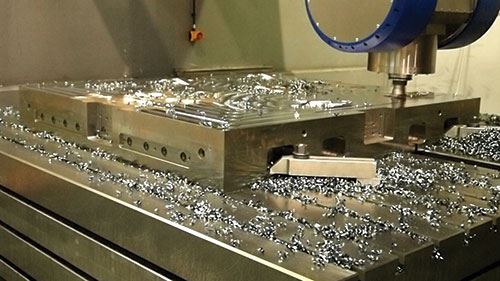How to Tackle Sophisticated Molds
Considering that semi-finishing and finishing processes account for 70 percent of the milling of a mold, it becomes obvious that using such a system can lead to huge productivity gains.
Increasingly sophisticated molds require increasingly sophisticated milling strategies and machine tool systems in order to prevent internal stresses in the mold and to counteract subsequent geometric distortions.
Using tools with small diameters of up to 66mm (2.59") as well as shallow depths-of-cut (ap) of up to 2mm (0.078“) can dramatically reduce these internal stresses, eliminating the need for posterior heat treatments, and thereby shortening delivery times of your molds. Selecting the right machine tool solution is another key aspect.
For the milling of tool steel, a linear machine tool system that uses roughing tools with diameters of up to 66mm (2.59“), depths-of-cut (ap) of up to 2mm (0.078“) and feedrates of up to 6000mm/min (236“/min) as well as a high-frequency milling spindle with an output of 63kW (84.5HP) and a spindle torque of 300Nm (221ft-lb) can achieve metal removal rates of approximately 0.75l/min (45.7in3/min).
The use of a direct motor spindle and direct-drive linear motors for X, Y, Z as well as torque motors for the rotary axis of the milling head can allow automatic monitoring and identification of wear and tear as well as cutting tool breakage. Plus it will automatically activate sister tools, if needed. This control function—based on controlling spindle torque and feeding force—is a feature to look for in your machine tool system.
Using a direct-drive linear motor system also allows for increased dynamics when compared to conventional drive systems. During semi-finishing and finishing processes, which require less spindle torque, these increased dynamics will drastically reduce machining time. This can result in productivity gains of up to 30 percent compared to conventional feed drive concepts.
Considering that semi-finishing and finishing processes account for 70 percent of the milling of a mold, it becomes obvious that using such a system can lead to huge productivity gains.
Machine tools with direct-drive linear motors for X, Y, Z and torque motors for C and A with the combined use of a direct motor spindle have several benefits to consider during your machine tool selection decision-making process, including: the ability to increase productivity due to a more dynamic performance regarding acceleration and jerks; control over the milling process by identifying wear and tear, and breakage of cutting tools; automatically reducing the feedrate as the milling tool enters into the corners of the workpiece, and as a result, changing the interaction between the milling tool and the workpiece; and, full control of the feed force during the milling operation—e. g. when increasing depth-of- cut (ap).
Related Content
-
Maintaining a Wire EDM Machine
To achieve the ultimate capability and level of productivity from your wire EDM on a consistent, repeatable and reliable basis, regular maintenance is a required task.
-
Exploring ISO 9000 - Part 16 Control of Quality Records
A Series of International Standards for Quality Management and Quality Assurance. We begin 2022 with a review of Clause 4.16 Control of Quality Records.
-
Surface Finish: Understanding Mold Surface Lingo
The correlation between the units of measure used to define mold surfaces is a commonly raised question. This article will lay these units of measure side by side in a conversion format so that companies can confidently understand with what they are dealing.
_970x90 1.png;maxWidth=970;quality=90)








_300x250 3.png;maxWidth=300;quality=90)



.jpg;maxWidth=300;quality=90)



